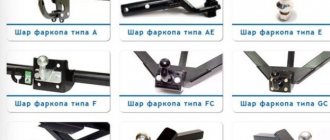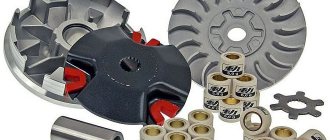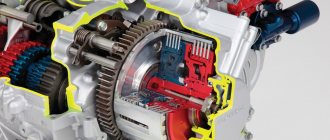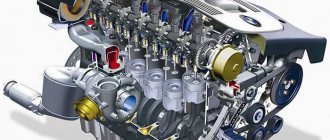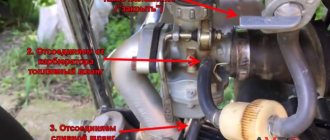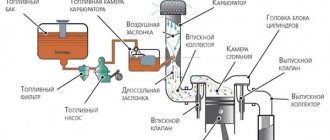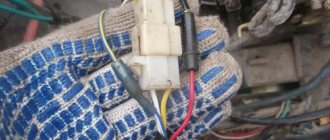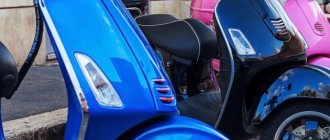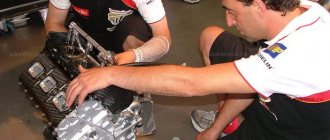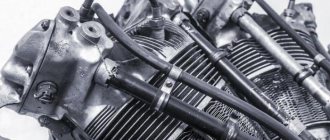If hunting and fishing are your favorite hobbies, the Renault Duster 4 4 is irreplaceable. It has optimal dimensions for moving along narrow country roads. The vehicle's cross-country ability does not cause any complaints from the owners. The car will take you to your dacha or to a picnic spot in nature without any problems.
Operation of Renault Duster has its own characteristics related to the rear wheel drive device.
How to turn on all-wheel drive
The electronic traction control system (ETC) is responsible for the vehicle's stability on the road. The result of this option is to block the possibility of slipping of a wheel that hits softer ground.
In addition, the ETS determines the need to connect the rear axle when road conditions worsen. The function operates automatically, but can also be adjusted at the driver’s request.
The drive is controlled using a round mode switch on the center console (near the gear shift knob). It displays the following positions: 2WD – AUTO – LOCK. They mean the following:
- The 2WD driving mode is selected for driving on good roads. These are city streets or country roads with high-quality road surfaces. Only front-wheel drive is connected - and in this case the Duster is no different from other front-wheel drive cars. Driving with the switch in the 2WD position helps to save fuel and allow the engine to operate at optimal speed. If you do not need to travel outside the city, you can use this function constantly.
- LOCK – this term means turning on all-wheel drive. In this case, the distribution clutch in the rear axle gearbox is blocked. Traction force is distributed to all wheels. This mode should be used when driving off-road or on slippery roads. For driving in LOCK mode, a speed limit is provided (no more than 70-80 km/h) in order to maintain the functionality of the gearbox.
- The position of the AUTO switch ensures that the choice of driving mode is carried out by the on-board computer. It determines how much power should be sent to the rear wheels if road conditions change. When driving on the highway, only front-wheel drive will work. If the road gets worse, part of the power (up to 50%) is transferred to the rear wheels. This significantly increases the stability of the car on bad or slippery roads, ensuring the safety of the people inside.
For beginners, it is recommended to use the AUTO function. This will make driving easier for an inexperienced driver.
Owner reviews
Many owners of Renault Duster cars speak differently about the all-wheel drive system, many tell in detail how all-wheel drive works and how to properly use this function in their car. Others help with their advice on when and how to engage all-wheel drive, and so on. This allows potential buyers to draw their own conclusions about the Duster. Moreover, often there are much more positive reviews than negative ones. Let's give you a few examples.
Alexey, driving experience 9 years:
“I bought my Renault Duster back in 2014, and in all that time I have driven 58 thousand kilometers. I often go fishing, hunting, to the countryside, that is, to places where an ordinary passenger car cannot reach. I can say for sure that the machine copes with its declared functions perfectly. Of course, not everything works perfectly, but what is there is enough. There were no breakdowns, but they say that the blocking function should not work constantly, otherwise breakdowns cannot be avoided.”
Pavel, driving experience 4 years:
“I’m not happy with the all-wheel drive system at all. At 60 thousand mileage the clutch flew off. The car was under warranty, the dealer quickly changed everything, and if it weren’t for the warranty, it would have cost me a lot of money. Fuel consumption is also 3 liters more than that of a car with front-wheel drive, but with the same power plant. I think it's all about how the clutch works. I read a lot of reviews and realized that this is normal. I want to sell my car and buy a front-wheel drive version.”
Principle of operation
The operating principle of Renault Duster all-wheel drive is similar to Nissan models: Terrano, Qashqai, X-Trai. The engine and gearbox are located transverse to the axis of the machine. To transfer torque to the rear wheels, a transfer case with an angular gearbox was added to the gearbox. The latter is necessary because the driveshaft connected to the rear axle runs along the longitudinal axis of the car.
The driveshaft is connected to an electromagnetic clutch, which controls the transfer of load to the rear wheels. Since it is necessary to transmit torque to the transverse rear axle, another angular gearbox is installed at the rear, combined with a differential. This, in turn, allows you to distribute forces on the wheels in such a way as to prevent slipping when cornering. This is the diagram of the rear axle gearbox.
The control clutch does not lock unless voltage is applied to the coil. In this case, no force is transmitted to the rear axle. Conversely, when locked, it allows up to 50% of the power to be transferred to the rear axle. This is done automatically (AUTO) or at the driver's discretion (LOCK).
FUN MATH
We took the Mazda CX-5 and Renault Duster, the hottest new products in the class. The all-wheel drive Duster even has a different rear suspension than its single-wheel drive brother - independent. Gearboxes for cars with a 2-liter engine are also tied to the number of drive wheels: automatic (and only it) is available in the 4×2 version, while 4×4 comes exclusively with a six-speed manual. In the Mazda CX-5, on the contrary, the type of drive has almost no effect on everything else. Even the level of equipment – thanks to option packages for the Touring and Sport trim levels. The biggest differences are in the tires and wheels. The 4×4 car is shod with 19-inch tires, the 4×2 modification is content with 17-inch ones.
Let's start measuring. Having driven the cars onto the scales, we find that all-wheel drive adds 70 kg to the Duster, and more than a hundred to the Mazda. Although, against the backdrop of a total curb weight of 1400–1500 kg, this is a trifle. There is not much difference in geometric cross-country ability; the front-wheel drive Duster has the latter even a little better.
Of the two Renaults, the all-wheel drive accelerates faster, but this is mainly due to the manual gearbox. The situation with Mazdas is more interesting. The mono-drive is more assertive during acceleration, which can be felt even without measuring equipment. Front-wheel drive has only a slight loss in maximum speed, but this is due to the selection of gear ratios and the large wheels of the 4x4 version. Both cars reached top speed in fourth gear, but the 4x2 on 17-inch tires hit the rev limiter early, unwilling to accelerate into the next gear, fifth.
By the way, the braking distance of both purely front-wheel drive cars turned out to be noticeably shorter.
Technical features of the coupling
The coupling connection consists of 2 parts: driving and driven. The first is connected to the driveshaft, and the second is connected to the main gear of the rear axle gearbox. When voltage from the on-board computer (2-8 V) is applied to the solenoid, the parts are attracted to each other. The force of connection of the parts is regulated by a ball “drive”, which allows you to dose the force transmitted to the rear wheels (according to the relay principle).
The electromagnetic clutch functions (transmits torque) when moving both forward and backward. It is triggered at the moment when, through the ABS sensors, the control unit receives information about the delay in rotation of the rear wheels in relation to the front (drive). If not full voltage is applied to the electromagnet, then the connection of the parts will be incomplete. In this case, the force on the rear wheels will be less than 50%. There are no temperature sensors. Temperature shutdown occurs automatically, according to data from ABS sensors.
FEELING THE DIFFERENCE
Well, how can we not remember the stereotypes regarding handling! During the rearrangement (simulation of avoiding an obstacle), it turns out that the Duster 2WD is faster and, most importantly, easier to drive. He, unlike 4x4, does not at all strive to perform the maneuver sharply. On the contrary: at first the monodrive surprises with large rolls and too calm reactions to turning the steering wheel. The all-wheel drive with its more active independent rear suspension behaves more assertively, and at times even restlessly, as if spurring the driver to respond. This car drives very confidently, especially considering the lack of a stabilization system. However, it is easy to make a mistake on it, and in the extreme, skidding of the rear axle will force you to slip out of the corridor. “Renault” with front-wheel drive requires you to twist the steering wheel from the heart in the fight against lag and understeer, but, unlike its brother, it slides more softly.
Both Mazdas have a sensitive stabilization system that intervenes in the control process quite early. But front-wheel drive again turns out to be clearer. So here, too, the advantage in the speed of rearrangement is with front-wheel drive and 17-inch wheels.
Public roads helped to finally set priorities. They showed better comfort of the single-wheel drive Mazda and its more correct behavior in corners. All-wheel drive on 19-inch tires does not like unevenness at all: vertical rocking and even slight yaw appear. This is not critical, but how much more comfortable and simpler is a front-wheel drive car. Moreover, such a crossover listens to the gas pedal much better. No thoughtfulness, no languid pauses even when the automatic transmission shifts to higher gears. The 4x4 version often suffers from failures, especially when the accelerator is pressed sharply.
What about “dusters”? Here, a car with front-wheel drive also turned out to be more comfortable. And even more noticeable than in the case of Mazdas. Both Renaults cope well with uneven road surfaces; this family dignity cannot be taken away from them. But if an all-wheel drive Renault still makes you feel the depth and size of potholes, sometimes quite sharply, then under the wheels of a front-wheel drive car most of them seem to dissolve, causing only slight swaying of the body. The most interesting thing is that the wheels on the Dusters are the same; the differences are rooted in the suspensions.
What could go wrong
The key to long-term operation of the machine is timely maintenance. Since Duster is often used in extreme road conditions, you should periodically check the belt tension and the serviceability of the suspension. The weak point may be the cardan shaft crosspieces. It is necessary to check them for play at all four attachment points. There are companies that replace the driveshaft assembly and balance it.
You should not forget about timely oil changes in the transfer case (front corner gearbox) and the rear axle gearbox. The timing depends on the operating conditions. If the car is often subjected to overloads when driving off-road, then the oil in these units is changed every 30,000-40,000 km.
Spare parts, maintenance
Products from the Dustershop77 range that may be of interest to you:
| Name | Manufacturer | Price | Availability | Add to cart |
| BR-001-GARD-URDP | Mud flaps enlarged (widened) Duster-GARD front | Duster-Guard | 1500 / 1200 rub. Discount: 1000 rub. | >10 |
| DC495 | Discount card (Dusterclubs.ru, Dustershop77.ru) | 700 / 500 rub. Discount: 500 rub. | >10 | |
| DC218 | Air deflector “Warm feet” for Duster, Logan, Sandero, Largus | 900 / 600 rub. Discount: 250 rub. | >10 | |
| patriot-001-1 | Gearbox coupling and gas tank protection (steel) | Patriot | 6500 / 5700 rub. Discount: 5300 rub. | 7 |
| 005-008502 | Trunk sill protection | Russian Artel | 1500 / 1300 rub. Discount: 1000 rub. | 6 |
| DC654 | Frill with fastening without 3M tape (Duster/Terrano) (ArtForm) | ArtForm (Yuago) | 3500 / 2500 rub. Discount: 1900 rub. | >10 |
| PT014-RDU112901 | Trunk sill trim PTGroup | Pt GROUP | 1500 / 1100 rub. Discount: 900 rub. | >10 |
| R12711 | Wind deflectors (window deflectors) COBRA/Autoplex | COBRA/Autoplex | 2000 / 1600 rub. Discount: 1500 rub. | >10 |
| NRD-009102 | Frill under the windshield (RA) | Russian Artel | 2500 / 2100 rub. Discount: 1800 rub. | 3 |
| RA0052 | Door sill trims (front+rear) RA | Russian Artel | 2500 / 2000 rub. Discount: 1700 rub. | 7 |
Summarizing
According to owner reviews, all-wheel drive on the Renault Duster is reliable. In order for the system to work for a long time and without breakdowns, the driver must pay attention to his driving style. It should be remembered that the main driving mode is 2WD (or AUTO).
Connecting all-wheel drive is not required so often, even on difficult roads. Use the LOCK mode only when absolutely necessary. After overcoming a dangerous place, you must immediately switch to AUTO. This will relieve the transfer case and rear gearbox from excess load and avoid damage. Replacing these units is expensive.
The all-wheel drive Renault Duster has good cross-country ability. The model fully meets the requirements for budget SUVs.
Versatile hard worker
In front-wheel drive, the Duster's first gear operates like the vast majority of manual transmission cars. Its gear ratio is smaller (3.73), which makes the car accelerate faster. I pressed the pedal a little, and the crossover already rushed forward. At the peak of the thrust of the 115-horsepower 1.6-liter engine, such a Duster in first gear travels at a speed of 40-45 km/h. Therefore, the five-speed is more convenient in the city, but it suffers off-road.
As a city car, the front-wheel drive Duster is incredibly good. He responds more interestingly to spurring. Because of the large door opening, you don’t sit in the driver’s seat, but enter as if into a personal office. The door swings wide, so you're not afraid to hit the roof with your forehead or eye. At the same time, the “wicket” is very light.
Alternative:
TagAZ Tager. The old-school frame SUV, born back in 1993 under the name SsangYong Korando, is somehow still alive. Actually, only this, besides the Duster, can be purchased with all-wheel drive and an automatic transmission at a price below 700 thousand rubles - an archaic three-door with an incomprehensible build quality is sold for 675,900 rubles
Suzuki Jimny. This Japanese baby already has almost a cult status, and for good reason: the tiny SUV has an honest frame design and is able to outshine many “adults” on off-road. However, this is where its advantages over the Duster end: there is catastrophically little space inside, there is almost no trunk, and prices for cars with automatic transmission start at 749,500 rubles.
Hyundai Santa Fe Classic. They say that somewhere there are the last examples of the previous generation Santa Fe, assembled, however, already in Taganrog. In principle, with a price starting from 825,900 rubles, this is a good alternative to the top-end Duster, which can cost a maximum of 806,500. The question, again, is with the quality of workmanship and the availability of cars at dealers - but formally, the “Classic” still remains an option.
Off-season difficulties
However, in spring or autumn there are still places where all-wheel drive is indispensable. For example, you need to drive a couple of kilometers to your dacha. And after the snow melted, the road was destroyed by a truck, which deepened the rut, and it became impassable for cars. Everyone is taking a detour through the virgin lands. Soggy loams overgrown with grass easily wrap around the wheels and the car gets stuck. Of course, the electronics of the front-wheel drive Duster help somehow get out. But you can’t argue with the laws of physics, and if there is no hook, then the crossover sinks out of the blue.
agu1954 › Blog › 11 Electric coupling of the rear gearbox on Duster 4x4
I apologize right away that this article is not about the Lacetti. But I think it will be useful to many Duster drivers. This is my son’s car, and I can do whatever I can to help keep him in check. So many people struggle with this problem. In general, the “saw” caught fire - the failure of this very clutch and the car turned from an all-wheel drive horse into a two-legged crossover. Poking and humming did not help. We decided to remove the clutch. It can be easily removed without removing the gearbox. — Drain the oil from the gearbox. — Remove the breather tube — Disconnect the wire block and the corrugation clips — Disconnect the cardan — Unscrew the 6 bolts securing the coupling and one securing the wires. — Make a mark on the flange for the cardan, how the coupling is connected to the gearbox. — Tear off the coupling from the sealant gasket and the rubber seal of the wires from the gearbox and remove the coupling. The most difficult thing is to tear off the sealant gasket. I rested the jack against the cardan flange from below and tore it off with a hammer blow on the cheek of the jack. We take the muff in our hands and carry it to the table. Disconnect the internal connector and examine the wires. Our black one was torn inside the insulation. We change the wires. To do this: Push the terminals out of the internal connector towards the wires. Tight but that's it. There are no locks, they are glued. The wires were taken from a dead computer power supply. We soldered it to the contacts of the internal connector and to the remaining tail of the external one. We press the back of the contacts for better contact and insert them into the housing until it stops. Clean the ends of the gearbox and coupling from the old sealant gasket, apply a new one to the gearbox. We place the coupling aligning our mark on the flange. We catch the stopper in a stubborn place, insert the rubber seal for the wires into the recess. Carefully seat the coupling all the way and tighten it with bolts. Top/bottom long bolts 4 pcs. and 2 shorter ones on the sides. We install the cardan, connect the breather, connector and clips of the wiring corrugations. Let the sealant-gasket dry and pour oil into the gearbox. Epilogue. The stopper, photo 2, allows the contact group to “swing” and the wire on the connector block breaks. The movement of this play is about a centimeter back and forth. The stopper has the shape of a round pin, and the groove (I forgot to take a photo) is square. The block is placed with the wires forward on the coupling, the rubber coupling on the gearbox. Turning the wires from the block 180` In general, an asshole designed this gearbox. The problem has disappeared. The car became all-wheel drive again.
Recommendations from experts
In order for the Renault Duster electric coupling to last longer, you must adhere to the following recommendations:
- Minimize the use of manual switching, since the on-board computer is automatically able to select the optimal modes.
- Avoid overloading the coupling, as this reduces its service life. As you know, the cost of replacing elements is high. Who has the desire to become a regular customer of a car repair shop?
- Motorists who use Renault Duster mainly off-road should install electromagnetic clutch protection. These measures are necessary in order to avoid mechanical damage to the component.
It is strictly undesirable to repair or replace the Duster clutch yourself - it is better to trust competent specialists.
